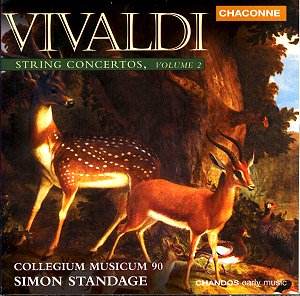The concertos on this recording are all what is called
concerti a quattro; these are works for string orchestra that
do not feature any solo instrument, violin or other. Similar to another
genre, the sinfonia da camera, these brief works are similar
in structure to opera overtures, being simple presentations of straightforward
themes in short, concise movements, with little development.
Some of them even sound as though they would fit in
an opera - the opening movement of the Concerto for strings, RV 163
'Conca' in B flat major has the familiar sound of the presentation of
thematic material found in an overture, or in a sinfonia inserted at
the beginning of an act.
This music is undemanding, both to the performers and
the listener. Vivaldi probably wrote these works for forces which contained
no virtuoso soloists, most likely for the instrumental concerts that
followed services at the Ospedale della Pietà, the foundling
home where Vivaldi worked. As most composers write to suit the musicians
available, these concertos show that his orchestra was limited.
The movements are all brief, less than 3 minutes, and
many are less than one minute long - in fact, none of these three movement
concertos is longer than 7 minutes, for all three movements. These hastily-written
works sound more like simple thematic explorations than truly accomplished
works. The fast movements generally show a fair amount of energy, yet
this energy dissipates in the lack of development. The slower movements,
which are, in many cases, the shortest movements in the concertos, are
often staid and regal sounding, as in the Andante from the Concerto
for strings, RV 153 in G minor, with its very simple melody played by
the violins over an even simpler part played by the rest of the strings.
This music is, nevertheless, Vivaldi, even if it is
far from his greatest. It is agreeable to listen to, but relatively
forgettable. The overall tone and atmosphere of this disc is interesting,
but the simplicity of the music makes it perhaps most suitable as background
music. In addition, there is a feeling that it all goes by very quickly
- this disc contains 36 movements in 65 minutes. By the time you start
getting into one of the movements, it is over.
While this is, indeed, Vivaldi, it is far from being
his best or most interesting music. It sounds like a starter without
a main course, with nothing to sink the teeth into. While the performance
and sound are excellent, this disc suffers from an overall lack of musical
qualities. While those wanting to own all of Vivaldi’s works will certainly
want this recording, others may just as well abstain.
Kirk McElhearn
